Mushrooms
Media

Species Types
Scientific Name
Laetiporus sulphureus
Description
Sulfur-colored chicken of the woods is an edible fungus with layered, fan-shaped, fleshy caps that are orange on top and sulfur yellow below. It grows in overlapping clusters on stumps, trunks, and logs of dead or dying deciduous trees, and on living trees and buried roots.
Media

Species Types
Scientific Name
Phlebia incarnata (formerly Merulius incarnatus)
Description
The coral-pink merulius is a small, semicircular bracket fungus that is pinkish to coral to cream-colored, wrinkled, and veined beneath. It grows on dead logs and stumps of deciduous trees.
Media
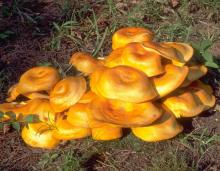
Species Types
Scientific Name
Omphalotus illudens (formerly O. olearius)
Description
Jack-o’-lanterns are bright orange to yellowish orange, with sharp-edged gills that descend the stalk. They grow in clusters, at the base of stumps, and from buried roots of oak and other deciduous wood.
Media
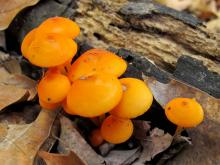
Species Types
Scientific Name
Mycena leaiana
Description
The orange mycena is a small, sticky, bell-shaped, orange mushroom. It grows in dense clusters on deciduous wood.
Media
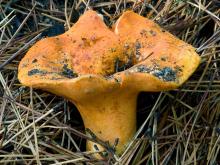
Species Types
Scientific Name
Hypomyces lactifluorum
Description
In a lobster mushroom, the cap, gills, and stalk of a host mushroom are covered by a finely bumpy, vivid orange to orange-red layer of mold. The gills of the host mushroom can be entirely obscured by the parasite.
Media
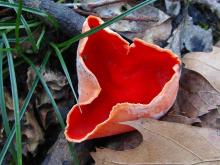
Species Types
Scientific Name
Sarcoscypha dudleyi
Description
The scarlet cup is small, red, and usually stalkless, with a white outer surface. It grows on fallen wet sticks and branches in damp deciduous woods.
Media
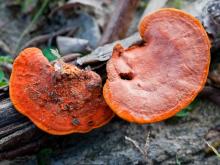
Species Types
Scientific Name
Pycnoporus cinnabarinus
Description
The cinnabar polypore is a bracket fungus that is tough, fan-shaped, and bright red-orange above and below. It grows on dead deciduous branches, twigs, and wood, mainly oak.
Media
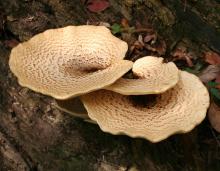
Species Types
Scientific Name
Polyporus squamosus
Description
The dryad's saddle is a large, fleshy, scaly, yellowish tan bracket fungus with large, yellowish white pores and a short stalk; it smells like watermelon rind. It grows singly or in layers, on living or dead deciduous wood.
Media
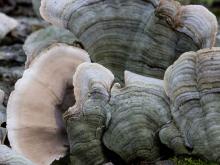
Species Types
Scientific Name
Stereum ostrea
Description
False turkey tail grows in large, layered groups of leathery, parchmentlike brackets with multicolored zones and a smooth underside. Look for it on stumps and logs of deciduous trees, especially oaks.
Media
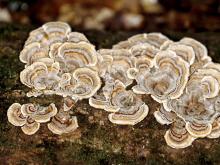
Species Types
Scientific Name
Trametes versicolor
Description
Turkey tail grows in clusters of leathery, thin brackets with multicolored zones above and whitish yellow pores below. Look for it on stumps and logs of deciduous trees.
See Also



Media

Species Types
Scientific Name
Monotropa hypopitys
Description
Pinesap is a plant that puts the "wild" in wildflower! It lacks chlorophyll, so its roots connect to fungi underground and absorb nutrients from the fungi.
Media

Species Types
Scientific Name
Cladophora, Pithophora, and Spirogyra spp., and others
Description
Filamentous green algae forms green, cottony masses that are free-floating or attached to rocks, debris, or other plants.
Media

Species Types
Scientific Name
Monotropa uniflora
Description
Indian pipe lacks chlorophyll, so it is white, not green. Below ground, its roots join with fungi that connect to tree roots. This plant, then, takes nourishment indirectly from the trees.
About Mushrooms in Missouri
Mushrooms are a lot like plants, but they lack chlorophyll and have to take nutrients from other materials. Mushrooms are neither plants nor animals. They are in a different kingdom — the fungi. Fungi include the familiar mushroom-forming species, plus the yeasts, molds, smuts, and rusts.
Always be cautious when eating edible mushrooms. Be absolutely sure of the ID, and only eat a small amount the first time you try it to avoid a reaction..





















